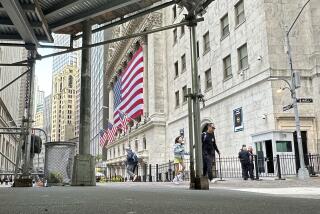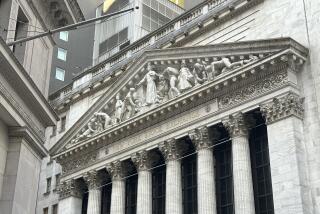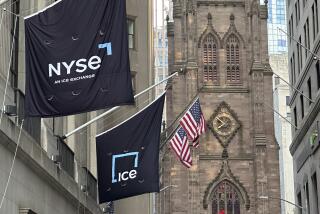Bull market stalls; can it reignite in 2016?

The year 2015 may end up best remembered for frustrating bulls and bears alike on Wall Street — and leaving little clarity for either about the new year.
The six-year-old stock bull market stalled out as most major U.S. share indexes posted losses for the 12 months. That disappointed the optimists.
But pessimists — and value hunters — also came away unsatisfied because the market’s declines were generally modest. Bearish investors had expected much more damage to stocks given the wild swings markets endured after mid-year, amid global economic jitters and a collapse of oil prices.
The Dow Jones industrial average slipped 2.2% for the year after falling 178.84 points, or 1%, on Thursday to close at 17,425.03. It was the Dow’s first annual loss since the crash year of 2008.
The broader Standard & Poor’s 500 index, a benchmark for many retirement accounts, ended down 0.7% for the 12 months after a 0.9% loss Thursday.
“This has been a year of ample volatility with little to show for it,” said Russ Koesterich, global chief investment strategist at money manager BlackRock Inc.
Even the market’s big winners were a source of investor angst: The huge 2015 gains in megatech stocks including Netflix (up 134%), Amazon (118%) and Google parent Alphabet (47%) while the broad market struggled reminded some analysts of the tail end of the late-1990s tech bubble. The tech-dominated Nasdaq index rose 5.7% for the year, the only winner among the best-known indexes.
Global growth worries were behind much of market trauma in 2015, particularly in late summer, when China suddenly devalued its currency against the dollar — another indication that the Chinese economy was slowing significantly. A weaker currency makes a country’s exports less expensive.
China’s move frightened investors already nervous about Europe’s slow recovery and apprehensive about the Federal Reserve’s plans to begin raising U.S. short-term interest rates. The result was a broad sell-off that by late September wiped out all or most of the year’s gains in stocks worldwide.
The collapse of oil prices and many other commodities in 2015 also stoked investor fears that the global economy was at risk of a new recession. So too did weak U.S. corporate earnings and a surge in yields on low-quality, or “junk” corporate bonds as investors pared back risk-taking.
But in the fourth-quarter economic gloom lifted somewhat.
After a flat reading in September, the Conference Board’s index of leading U.S. economic indicators rose in October and November, suggesting continued growth. Japan’s economy continued to expand, defying expectations that it had slipped back into recession. And China’s stock market stabilized after its summer crash, leaving the main Shanghai index up 9.4% for the year.
Crude oil prices, by contrast, fell further in December, ending at $37.07 a barrel — down 38% from a year earlier and near the lowest level since 2009.
In the second half of the year, the dive in crude unnerved financial markets because it raised the specter of a deflationary economic bust. But analysts noted that oil was being pushed lower by a global glut of supply, not by a sudden slump in demand.
And even as crude’s woes slam oil producers, including the U.S. Midwest shale-oil belt, the plunge in prices is a consumer and business windfall that should underpin the economy.
“Rising oil prices very frequently cause recessions, but not falling prices,” notes Don Rissmiller, chief economist at Strategas Research Partners.
Nonetheless, overall global growth still is expected to be subpar in 2016. Christine Lagarde, managing director of the International Monetary Fund, this week warned that growth would be “disappointing and uneven,” in part because of China’s deceleration and the U.S. Fed’s decision to begin tightening credit.
The IMF’s most recent forecast, in October, called for 3.6% real global growth in the new year — far below the 5%-plus levels before the 2008 financial crisis.
But Jeffrey Kleintop, chief global investment strategist at Charles Schwab & Co., thinks Europe and Japan could be big beneficiaries of cheap energy prices in 2016. He noted that while U.S. stocks mostly lost ground in 2015, European and Japanese stock markets posted gains. He thinks developed markets “are still the place to be in 2016,” as opposed to emerging markets.
Japan’s Nikkei-225 stock index rose 9.1% in 2015 measured in yen. The Italian market rallied 12.6%, German stocks rose 9.6% and France was up 8.5%, all measured in euros.
As 2016 begins, one market hurdle already is out of the way: the Fed’s first rate hike. The central bank in December raised its benchmark short-term rate from near zero to a minimum of 0.25%, citing the U.S. economy’s recovery since the financial crash.
The move failed to ruffle markets much because it was so widely expected. Likewise, the Fed has telegraphed that it expects to move very slowly in taking rates up from here, with perhaps four quarter-point increases over the next 12 months. Meanwhile, central banks in most of the rest of the world are expected to cut rates further or leave them steady in 2016 to bolster their economies.
All in all, “there is nothing on the horizon suggesting that interest rates will do anything in 2016 other than remain very low,” said David Kotok, head of money manager Cumberland Advisors. That should continue to be a plus for markets, he said.
For U.S. stocks, one issue looms largest as investors look to the new year: What happens to corporate earnings?
Sales and profits were under pressure in 2015 in part as the dollar continued to rise against most other world currencies. That can make U.S. goods more expensive abroad, eroding demand. Also, whatever money U.S. multinational companies earn abroad in weak currencies translates into fewer dollars, further depressing companies’ financial results.
The strong-dollar effect zapped many U.S. exporters in 2015, particularly those tied to commodity markets. Shares of U.S. Steel plummeted 70%, machinery giant Caterpillar dove 26% and energy titan Chevron slumped 20%.
Overall, operating earnings of the Standard & Poor’s 500 index companies for 2015 are expected to be off 0.8% from 2014 levels, weighed down by a plunge in energy-company results, according to S&P Capital IQ.
But analysts remain optimistic about 2016, forecasting a 7.9% increase in profit, said Sam Stovall, U.S. equity strategist at S&P Capital IQ. Earnings growth is expected to be helped by cheaper energy costs and by another round of cost-cutting, Stovall said.
If earnings instead turn lower while the Fed keeps lifting interest rates, however, stocks will lose two crucial elements that have supported the bull market since March 2009: rising profits and ultra-cheap money.
More to Read
Inside the business of entertainment
The Wide Shot brings you news, analysis and insights on everything from streaming wars to production — and what it all means for the future.
You may occasionally receive promotional content from the Los Angeles Times.










